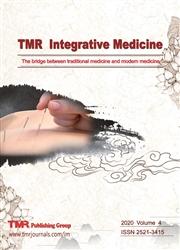Study on Yan-Xin Wang’s medication experience and regularity in treating Insomnia from the liver based on data mining
引用次数: 0
Abstract
Backgroun d: Professor Yan-Xin Wang has been committed to the use of traditional Chinese medicine formulas to treat insomnia from the liver for many years, and has achieved excellent clinical results. In order to better inherit Yan-Xin Wang’s academic thoughts. The purpose of this study is to use clinical data to explore the clinical experience of Prof. Yan-Xin Wang in the application of Chinese medicine to treat insomnia patients from the liver, explore the compatibility and medication rules of traditional Chinese medicine, and give more clinical treatment ideas for insomnia. Methods: The general data and prescription information of insomnia patients treated with Chinese herbal medicine by Prof. Yan-Xin Wang from January 1, 2021, to December 31, 2021, were summarized according to the inclusion and exclusion criteria, and the data were subjected to frequency statistics and drug association rules, complex network diagram analysis and cluster analysis. Results: A total of 159 patients and prescriptions were included in the study, of which 81.1% were women and 18.9% were men, containing 128 herbs; the highest frequency of use was 91.8% for Bupleuri Radix . Six Chinese herbs were used more than 70% of the time, namely Bupleuri Radix , Scutellariae Radix , oyster shell, Glycyrrhizae Radix , Os Draconis, and Ziziphi Spinosae Semen . The top 20 herbs in terms of frequency of use were analyzed in terms of the four Qi, five flavours, and their attributions. The four Qi were mainly calm and warm, the five flavours were mainly bitter and acrid, followed by sweet, and the attributions were mainly to the liver, spleen, and heart meridians. The Chinese medicine association rules set the confidence level > 80% and the support level > 10%, resulting in 10 two-herb and three-herb associations with the highest confidence level, such as Os Draconis is associated with oyster shell, Platycodonis Radix is associated with Achyranthis Bidentatae Radix , Scutellariae Radix is associated with Bupleuri Radix , Os Draconis, Bupleuri Radix is associated with oyster shell, Os Draconis, Scutellariae Radix is associated with oyster shell, etc. Cluster analysis yielded 3 classes of drug formulas. The complex network diagram shows that the core prescription drugs are composed of Bupleuri Radix , Chuanxiong Rhizoma , Pseudostellariae Radix , Jujubae Fructus , Os Draconis, Coptidis Rhizoma , Scutellariae Radix , Ziziphi Spinosae Semen , Smilacis Glabrae Rhizoma , Cinnamomi Cortex , White Moutan Cortex , Atractylodis Rhizoma , Glycyrrhizae Radix , oyster shell, Rehmanniae Radix Praeparata , Tritici Levis Fructus , Pinelliae Rhizoma Praeparatum , and Cinnamomi Ramulus . Conclusion: Prof. Yan-Xin Wang believes that the main treatment for patients with insomnia is based on the liver, by tonifying the deficiency and supporting the righteousness, mutually regulating the liver and spleen, and calming the mind and nourishing the heart, while adding and subtracting appropriate herbs according to the patient’s co-morbidities, which can significantly improve the patient’s insomnia symptoms基于数据挖掘的王衍欣治疗肝脏失眠症用药经验及规律研究
背景:王彦欣教授多年来一直致力于利用中药方剂从肝脏治疗失眠,并取得了优异的临床效果。为了更好地继承王严信的学术思想。本研究旨在利用临床资料,探讨王彦欣教授应用中医从肝治疗失眠患者的临床经验,探索中医的配型及用药规律,为失眠的临床治疗提供更多思路。方法:根据纳入标准和排除标准,对王彦欣教授于2021年1月1日至2021年12月31日使用中草药治疗失眠患者的一般资料和处方信息进行汇总,并对数据进行频次统计和药物关联规则、复杂网络图分析和聚类分析。结果:共纳入159例患者和处方,其中女性占81.1%,男性占18.9%,共含中药128种;柴胡的使用频率最高,为91.8%。柴胡、黄芩、牡蛎壳、甘草、龙骨、酸枣等6种中草药的使用率超过70%。根据四气五味及其归属分析了使用频率最高的20种草药。四气以平和温热为主,五味以苦和辛辣为主,其次是甜,归因主要是肝、脾和心经。中医协会规则设置置信度>为80%,支持度>为10%,得到10个置信度最高的二、三药协会,如天龙子与牡蛎壳相关、桔黄与牛膝相关、黄芩与柴胡相关、天龙子、柴胡与牡蛎壳相关、天龙子、黄芩与牡蛎壳相关等。聚类分析得到3类复方。复杂网络图显示,核心处方药物由柴胡、川芎、太子参、枣子、龙骨、黄连、黄芩、紫子、菝葜、桂皮、白牡丹皮、苍术、甘草、牡蛎壳、地黄、小麦、半夏、桂皮组成。结论:王延欣教授认为,失眠患者的治疗以肝为本,补虚扶正,肝脾相调,安神养心为主,同时根据患者的合并症适当加减草药,可明显改善患者的失眠症状
本文章由计算机程序翻译,如有差异,请以英文原文为准。
求助全文
约1分钟内获得全文
求助全文

 求助内容:
求助内容: 应助结果提醒方式:
应助结果提醒方式:


